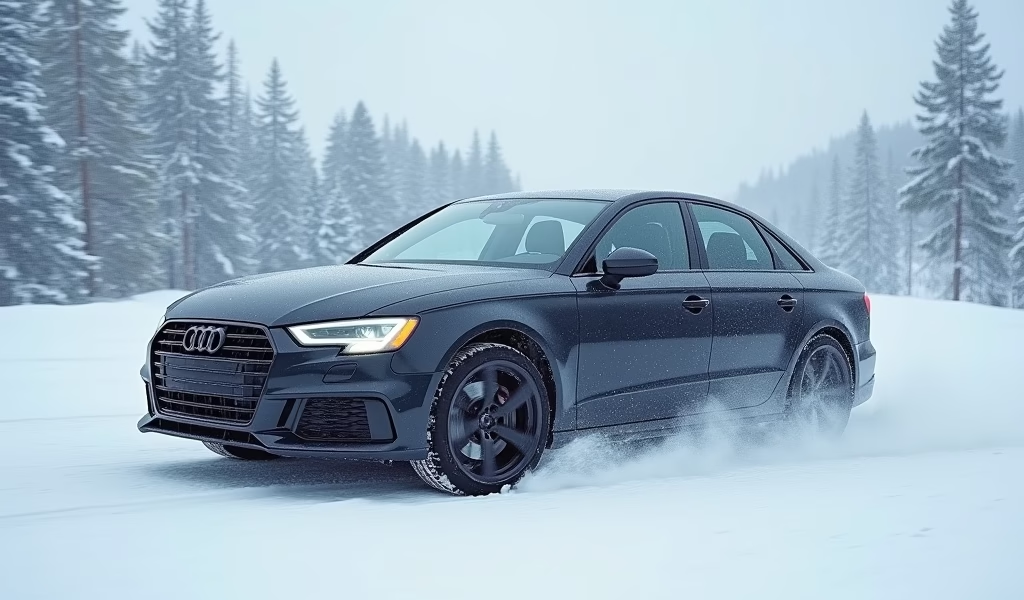Overview
Snow tires are specially engineered with unique rubber compounds that remain flexible below 45°F, deeper tread patterns with extensive siping for better grip, and can reduce stopping distances by 30-40% compared to all-season tires in winter conditions. For optimal winter driving safety, experts recommend installing a complete set of winter tires (identified by the Three-Peak Mountain Snowflake symbol) before temperatures consistently drop below 45°F, maintaining proper inflation throughout the season, and storing them properly during warmer months.
Table of Contents
- What Are Snow Tires?
- How Snow Tires Work
- Top 5 Winter Tire Tips
- When to Install Snow Tires
- Snow Tires vs. All-Season: What’s the Difference?
- Maintaining Your Snow Tires
- Conclusion
- Frequently Asked Questions
What Are Snow Tires?
Let me tell you something about snow tires that might surprise you – they’re not just regular tires with a fancy winter name slapped on them. As someone who’s been getting my hands dirty with vehicles for over 20 years, I’ve seen firsthand how what are snow tires can literally be lifesavers when the mercury drops and the roads turn white.
Snow tires (also called winter tires) are specifically engineered rubber companions designed to perform in temperatures below 45°F (7°C), on icy roads, and through snow-packed conditions. Unlike your standard all-season tires, these specialized tools come with unique tread patterns, rubber compounds, and construction features that give you better traction, improved braking, and more reliable handling during the cold months.
Think of them as the specialized winter boots to your regular shoes. Sure, you could walk through snow in your everyday sneakers, but you’d slip, your feet would get cold, and the journey would be downright treacherous. The same applies to driving in winter with the wrong tires.
According to a study by Tire Rack, vehicles equipped with winter tires can stop up to 30-40% shorter on snow and ice compared to all-season tires. That could be the difference between a close call and a costly fender bender.
How Snow Tires Work
The magic of snow tires lies in three key features that work together to keep you safe when roads get dicey. First off, we have the rubber compound. Winter tires use special rubber formulations that stay flexible in frigid temperatures, unlike all-season or summer tires that get stiff (and less grippy) when the temperature plummets.
Think of it this way: drop a rubber ball on the ground at room temperature, and it bounces nicely. Put that same ball in the freezer for a few hours, and it’ll thud to the ground with hardly any bounce. That’s exactly what happens with regular tire rubber in winter – it loses its ability to conform to the road. Winter tires use silica-rich compounds that maintain their elasticity even when it’s cold enough to see your breath.
Second comes the tread design. Take a close look at a snow tire, and you’ll notice thousands of tiny slits cut into the tread blocks. We call these “sipes,” and they’re absolutely crucial for winter performance. These little marvels create biting edges that grip snow and ice, almost like thousands of tiny claws digging in for traction. Plus, the wider grooves between tread blocks help channel away slush and water, reducing your risk of hydroplaning.
Finally, there’s the overall tread pattern itself. Winter tires typically feature deeper, more aggressive treads with unique block shapes designed to compact snow within the grooves. This might sound counterintuitive, but it’s brilliant engineering – snow sticks better to snow than to rubber, so these tires actually use the snow itself to create more traction on snowy roads.

Top 5 Winter Tire Tips
After decades in the shop and countless winter seasons helping customers navigate safely through the cold months, I’ve developed these five essential tips for making the most of your winter tires:
1. Install a Complete Set
I can’t stress this enough – always install a full set of four winter tires. I’ve seen too many folks try to save money by putting snow tires only on their drive wheels (front or rear), and it’s a dangerous gamble. This creates an imbalance in traction that can cause unpredictable handling, especially during cornering or emergency maneuvers.
When your front wheels have good grip but your rear ones don’t, you’re setting yourself up for fishtailing and potential spinouts. Conversely, good rear traction with poor front traction limits your steering control. Safety experts at NHTSA agree – four matching winter tires provide balanced handling that could save your life when conditions get nasty.
2. Pay Attention to the Snowflake Symbol
Not all winter-marketed tires are created equal. Look for the “Three-Peak Mountain Snowflake” (3PMSF) symbol on the sidewall. This isn’t just marketing – it’s an industry certification showing the tire has been tested and proven to provide a minimum level of snow traction performance.
Tires with this symbol have undergone specific acceleration tests on medium-packed snow and met or exceeded industry requirements. It’s your assurance that you’re getting genuine winter performance, not just winter-sounding marketing claims. The difference in real-world grip can be substantial, especially in severe conditions.
3. Consider Studded vs. Studless Options
Depending on where you live, you might need to choose between studded and studless winter tires. Studded tires have small metal pins embedded in the tread that provide exceptional grip on ice, acting like tiny picks digging into slippery surfaces. They’re the heavy artillery of winter driving.
However, they’re not always the best choice. Modern studless winter tires have come a long way and now provide excellent ice traction through advanced rubber compounds and tread designs. Plus, they’re quieter, less damaging to roads, and legal everywhere (some regions restrict or prohibit studded tires). For most drivers in most conditions, today’s premium studless winter tires offer the best balance of performance and convenience.
4. Don’t Wait Until the First Snowfall
Every year, the first real snowfall brings a flood of panic-stricken customers to my shop looking for immediate winter tire installation. By then, it’s often too late – good winter tires may be sold out, and installation appointments backed up for weeks.
Remember, winter tires aren’t just for snow – they’re for cold temperatures. That’s why I tell my customers to use the “Thanksgiving to Tax Day” rule in most northern areas, or more precisely, to make the switch when temperatures consistently fall below 45°F (7°C). The rubber compounds in all-season and especially summer tires begin to harden at these temperatures, reducing traction even on dry roads.
5. Proper Storage Matters
When spring rolls around and it’s time to remove your winter tires, don’t just toss them in a corner of your garage. Proper storage will extend their life and ensure they’re ready when winter returns.
Clean your tires thoroughly before storage, removing road grime and salt. Store them in a cool, dry location away from direct sunlight, ozone sources (like electric motors), and heat sources. If possible, store them in individual air-tight bags to prevent the rubber from drying out. And whether you stack them or hang them depends on whether they’re still on rims (stack if mounted, hang or stack flat if not).
When to Install Snow Tires
Timing is everything when it comes to winter tire installation. I’ve seen both extremes in my shop – folks putting snow tires on in September (way too early) and others sliding into my lot in January after a fender bender (way too late).
The ideal time to install winter tires isn’t based on a specific date but on temperature patterns. When overnight temperatures regularly dip near freezing and daytime highs consistently stay below 45°F (7°C), that’s your signal. For most northern regions, this typically means mid-to-late October or early November.
Installing too early means you’ll wear your soft winter rubber compounds unnecessarily on warm roads. This accelerates wear and can actually reduce the effective lifespan of your expensive winter rubber. On the flip side, waiting too long means you’re driving on compromised traction during those first cold snaps when your reflexes haven’t yet adjusted to winter driving conditions.
For removal, follow the same temperature-based approach in reverse. When daily temperatures consistently stay above 45°F (7°C), it’s time to switch back to your all-seasons or summer tires. In most areas, this falls somewhere between late March and mid-April.
Remember that elevation matters too. If you live in a mountainous area where you regularly travel between significantly different elevations, base your timing on the colder conditions you’ll encounter. It’s better to have winter tires on warm lowland roads than all-seasons on frigid mountain passes.
Snow Tires vs. All-Season: What’s the Difference?
One of the most common questions I get in my shop goes something like this: “I’ve got all-season tires. The name says ‘all seasons,’ so why do I need special winter tires?” It’s a fair question, and the answer lies in understanding what “all-season” really means in tire terminology.
All-season tires are essentially a compromise designed to provide acceptable performance across a wide range of conditions. Think of them as the jack-of-all-trades, master of none in the tire world. They’ll handle light snow and occasional winter conditions, but they prioritize year-round versatility, reasonable tread life, fuel economy, and comfortable ride quality.
Winter tires, by contrast, are specialists. They sacrifice some warm-weather performance, tread life, and fuel efficiency to excel in one specific condition: winter. The differences are substantial and show up in several key areas:
Rubber compound is perhaps the most crucial difference. All-season tires use compounds designed to work across a wide temperature range, which means they inevitably harden when temperatures drop below freezing. Winter tires use specialized rubber compounds with higher natural rubber content that stays pliable even in freezing conditions, maintaining the critical flexibility needed for traction.
Tread design also differs dramatically. All-season tires typically have tread patterns optimized for wet and dry conditions with some consideration for light snow. Winter tires feature more aggressive, deeper treads with specific patterns engineered to evacuate snow and slush while providing maximum bite on snow and ice.
Siping (those tiny slits in the tread blocks) is much more extensive on winter tires. These create thousands of additional biting edges that dramatically improve grip on slippery surfaces. If you looked at the two tires side by side under magnification, you’d see that winter tires might have 10 times the number of sipes.
The proof is in the performance. In winter conditions, the stopping distance difference between quality winter tires and even the best all-season tires can be 30-40% on snow and ice. That could mean the difference between stopping safely and sliding through an intersection.

Maintaining Your Snow Tires
Taking proper care of your winter tires extends their life and ensures they perform at their best when you need them most. After installing thousands of sets over my career, here are the maintenance tips I share with all my customers:
Proper inflation is absolutely critical for winter tires. Cold temperatures cause tire pressure to drop – typically about 1 PSI for every 10°F drop in temperature. This means the pressure you set in November could be dangerously low by January if you’re not checking regularly. Under-inflated winter tires wear faster, handle poorly, and actually provide worse traction in snow despite the common myth that lower pressure is better in snow.
Check your pressure at least twice monthly throughout winter, preferably when the tires are cold. Follow the manufacturer’s recommended PSI, which you’ll find on the driver’s door jamb sticker or in your owner’s manual – not the maximum PSI molded on the tire sidewall.
Regular rotation is even more important for winter tires than for all-seasons. The soft compounds and aggressive treads of winter tires tend to wear faster, and uneven wear can significantly reduce their effectiveness. Have your winter tires rotated halfway through each winter season or every 4,000-5,000 miles of winter driving.
Wheel alignment should be checked when installing your winter set, especially if you notice any pulling or uneven wear on your regular tires. Winter driving with misaligned wheels compounds the problem, causing accelerated and uneven wear that can quickly ruin an expensive set of winter tires.
Track your tread depth throughout the season. Winter tires need deeper tread than all-season tires to function properly in snow. While the legal minimum is typically 2/32″, winter tires lose much of their snow traction below 6/32″. Use a proper tread depth gauge or the penny test (Lincoln’s head should be partially covered when inserted into the tread) to monitor wear.
Finally, never mix winter tires with non-winter tires. The traction difference creates dangerous handling imbalances that can cause unpredictable behavior, especially during emergency maneuvers. If one winter tire is damaged beyond repair mid-season, replace it with an identical model or, if that’s not possible, replace both tires on that axle.
Conclusion
When we talk about what are snow tires, we’re really discussing a crucial safety system for your vehicle that’s just as important as your brakes or airbags during winter months. These specialized tires aren’t a luxury or an unnecessary expense—they’re an investment in your safety and peace of mind when roads turn treacherous.
The specialized rubber compounds, aggressive tread patterns, and unique construction features of winter tires work together to provide significantly better traction, shorter stopping distances, and more predictable handling in cold, snowy, and icy conditions. The difference is so substantial that even vehicles with all-wheel drive benefit tremendously from proper winter rubber.
Remember to install a complete set before temperatures consistently fall below 45°F, look for the mountain/snowflake symbol for certified winter performance, and maintain them properly throughout the season. When spring arrives, store them correctly to ensure they’re ready for next winter.
Your vehicle can only brake, accelerate, and corner as well as your tires allow—and in winter conditions, no tire performs like a dedicated winter tire. As someone who’s spent decades helping drivers stay safe through harsh winters, I can tell you that the peace of mind and genuine safety benefits are well worth the investment.
Ready to upgrade your winter driving safety? Contact your trusted local tire professional today to discuss the best winter tire options for your specific vehicle and driving needs. Don’t wait until the first snowfall—plan ahead and ensure you’re prepared when winter arrives.
Frequently Asked Questions
How much do snow tires typically cost?
Snow tires typically range from $80-$200+ per tire, depending on size and quality. Factor in mounting and balancing costs ($60-$100 for a set) plus possible need for dedicated winter wheels.
Can I use snow tires year-round?
No, using snow tires year-round isn’t recommended. Their soft compounds wear quickly in warm weather and their performance on dry/wet roads in summer is inferior to all-season or summer tires.
Are winter tires worth it if I have all-wheel drive?
Absolutely – AWD helps with acceleration but doesn’t improve braking or cornering. Winter tires improve stopping distance by up to 40% compared to all-seasons, even with AWD.
How many seasons do winter tires typically last?
With proper care, winter tires typically last 3-4 seasons for average drivers. Actual lifespan depends on driving conditions, maintenance, and storage practices during off-seasons.
Do I need special wheels for my winter tires?
It’s not required but highly recommended. Dedicated steel or alloy winter wheels protect your main wheels from salt damage and make seasonal changeovers faster and less expensive.

